Seeing is Believing?
This page illustrates that our visual perception cannot always be trusted. The components of an object can distort the perception of the complete object. Our mind is the final arbiter of truth. Most optical illusions are the result of 1) incongruent design elements at opposite ends of parallel lines, 2) influence of background patterns on the overall design, 3) adjustment of our perception at the boundaries of areas of high contrast, 4) afterimages resulting from eye movements or from kinetic displays, or 5) inability to interpret the spatial structure of an object from the context provided by the picture.
 The Parthenon |
Optical illusions have been studied for millenia. The ancient Greeks used a technique known as entasis which incorporates a slight convexity in the columns of the Parthenon to compensate for the illusion of concavity created by parallel lines. Many of the following illusions have been popularized by psychologists and artists like Hering, Ehrenstein, Meyer, Zöllner, Müller-Lyer, Poggendorf, and Escher.
How can the man go up all the time? Can such a staircase be built as a real object?

and in the lower part of the "X"
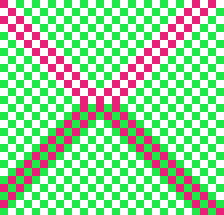


You can go from corner A to corner B by climbing the stairs or by going around a level plane.
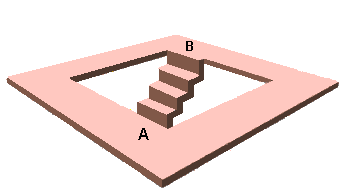
The vertical zigzag patterns disrupt our horizontal perception.

Can you find a relationship between this triangle and a Möbius strip?
( Hint: Assume that the thickness of the strip is the same as the width of the strip,
and that instead of twisting 180 degrees before joining, there is only a 90 degree twist. )



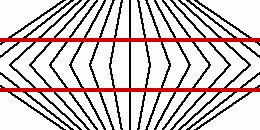

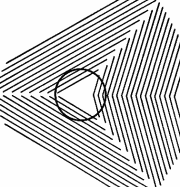 | 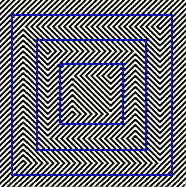 |


Our intuition about perspective influences what we see.

Incongruous design elements on opposite ends of the parallel lines create confusion.

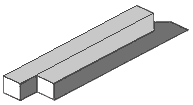
Without depth clues, this line drawing has two different three-dimensional interpretations.


The shade of the background influences how we perceive it. All squares are uniformly shaded,
but each square seems lighter on its left edge than on its right edge.


The image in the lower right corner is upside-down, and the image to the right is rotating. Our interpretation of bumps and indentations is conditioned by the fact that objects are generally illuminated from the top. The rotating image may be interpreted as a wobbly elongated object viewed from the end (like a finger pointed in your direction) or as a ball rotating inside a washing machine viewed through the porthole. The ambiguity is caused because we don't have any clues to decide whether the bright portion of the image is above or below the display plane.

Apparent movement of the streams is created by afterimages
as our eyes shift to examine the picture.

© 1998, Sarcone and Waeber
The background of concentric circles makes the squares appear distorted.
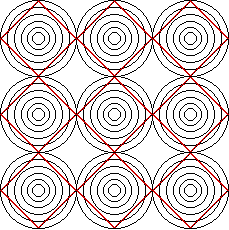
The circles appear to rotate when you move your head closer and further away from the screen while looking at the dot in the center. Our peripheral vision interprets the relative increase or decrease of the image in the retina as rotational motion of the slanted lines.

There are no curved lines in these figures. You can use a ruler to check it out.
The diagonal patterns created by the tiny squares distort the perception of the pictures.
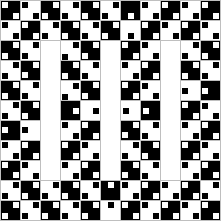
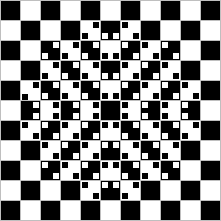
The retina is the part of the eye covered with receptors that respond to light. A small portion of the retina where the optic nerve connects to the brain has no receptors. An image that falls on this region will not be seen. Close your right eye. With your left eye, look at the L below. Slowly move your head closer or further away from the screen while looking at the L. The R will disappear when your head is approximately 50 cm (20 in) from the screen. You can repeat the experiment with your right eye by looking at the R.
An afterimage is a visual impression that remains in the retina after the initial stimulus is removed. The afterimage always has colors that are complementary to those of the original image. Look steadily at the cross in the center of the picture to see an afterimage.
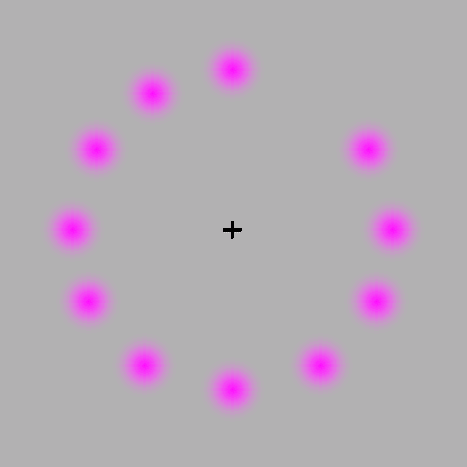
Created by Jeremy L. Hinton ca. 2005 as "Lilac Chaser"
Take two pieces of heavy paper. On one of them make three holes with a pin spaced about 2 mm apart (1/16 inch) from each other forming a triangle. On the other one piece of paper, make a single hole with the pin. Place the card with the three holes next to your eye and look through the holes at the card with one hole. You will see three holes instead of one, and the pattern of holes will be upside down.

Stereoscopic vision makes depth perception possible. By crossing your eyes while looking at these pictures, the brain perceives a combined three-dimensional image. (Hint: Keep your eyes level with the pictures. Place your fingertip between the pictures just below the sun and look at your fingertip while you bring your finger toward your eyes. When your fingertip is approximately 7 inches (20 cm) from your eyes, the pictures in the background will combine into a 3-dimensional picture.)
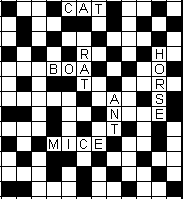


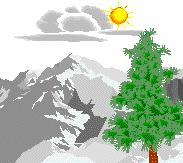
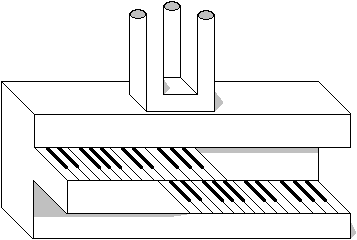
Hold your head steady and fix your eyes on the dot in the center of the picture. The colored dots will seem to disappear in a few seconds. The effect is due to retinal fatigue which occurs when the afterimage of an object cancels the stimulus of the object on the retina. The effect is most pronounced when the objects do not have well-defined edges that are detectable by small eye movements.

This is another example of incongruous design elements on opposite ends of parallel lines.
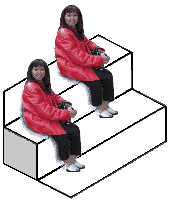
The squares labeled A and B are the same shade of gray. This can be verified by joining the squares marked A and B with two vertical stripes of the same shade of gray. The illusion that B is lighter than A is caused by the relative contrast of the surrounding dark squares and by the fact that our vision compensates for the shadow of the cylinder. Created by Edward H. Adelson, Professor of Vision Science at MIT.

Although there are only circles with sections taken out of them, our eyes strive to see triangles. The sides of the triangles may appear curved when the angles of the sections do not add up to 180 degrees.

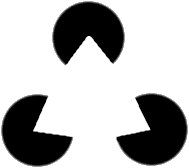
A portion of misplaced lines can be clearly identified as forming a circle, even when there is no outline of a circle.
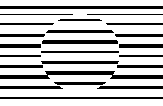
Animals which blend with the color and texture of their environment are more likely to survive either as prey or as predators. Camouflaged prey have a greater chance of surviving by avoiding detection, whereas camouflaged predators can hunt more successfully if they can approach the prey without being seen.


The coloration of zebras makes them very conspicuous in the African plains, but the pattern of black and white stripes makes it very hard for predators to distinguish one individual in the middle of the herd. Do you see eight or nine zebras?
The figure in the top can be interpreted as a cube or as a corner. The darker shading of the bottom section reinforces the interpretation of a cube illuminated from the top. The figures below it add some elements that help us to disambiguate.
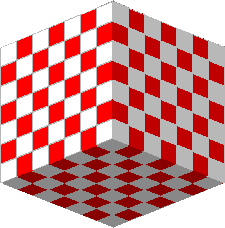
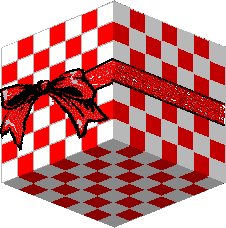

Afterimages of complementary colors create apparent movement in our peripheral vision
as our eyes shift across the page.

Derived from a design by A. Kitaoka
Silhouettes may have ambiguous interpretations. In this example, the silhouette of the lady may be interpreted as a front view or as a back view.



On what leg is the dancer standing? The direction of rotation of silhouettes may be ambiguous. This dancer created by Nobuyuki Kayahara stands on her left leg when she appears to be rotating clockwise, but on her right leg when she appears to rotate counter-clockwise.
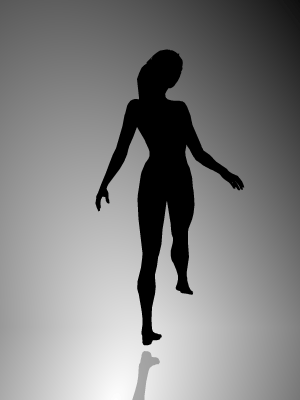
Put Mouse Pointer Here to Animate
People with normal color vision can perceive numbers formed by patterns of colored dots in every circle. If you do not see some of the numbers, you should have your eyes checked and consider working in a job where color discrimination is not critical.
Approximately 6%-8% of people of European descent, 4%-6% of people of Asian descent, and 2%-4% of people of African descent have some type of defective color vision. Images based on Tests for Colour Blindness by Dr. Shinobu Ishihara.
 25 25 |  29 29 |
 45 45 |  56 56 |
 6 6 |  8 8 |
As an experiment, look at these circles with blue-red 3D glasses, first with one eye, and then with the other. Some of the numbers will not be visible! Also, use the glasses to look at the word color test below and explain the results.
BLACK RED GREEN
PURPLE YELLOW RED
ORANGE GREEN BLACK
BLUE RED PURPLE
GREEN BLUE ORANGE
This is a type of psycholinguistic test that poses some difficulty because the portion of the brain that handles language has the conflicting tasks of verbalizing the color of the written words while ignoring the meaning of words representing colors.
 ←Pikachu
←Pikachu On December 16, 1997 hundreds of Japanese children suffered seizures and convulsions following their viewing of a "Pocket Monsters" cartoon on television. Most children said they felt sick and had vision problems during a scene where the entire background was flashing red and blue. Additional children ended up in the hospital after the cartoon segment was replayed in the evening news. Neurologists believe that the children suffered photosensitive epilepsy induced by the flashing. Abnormal EEG can be triggered by flickering lights in a small percentage of persons when the flickering frequency is 5-10 hertz for children and 15-20 hertz for older people. Excessive TV watching can damage a child's development and education.
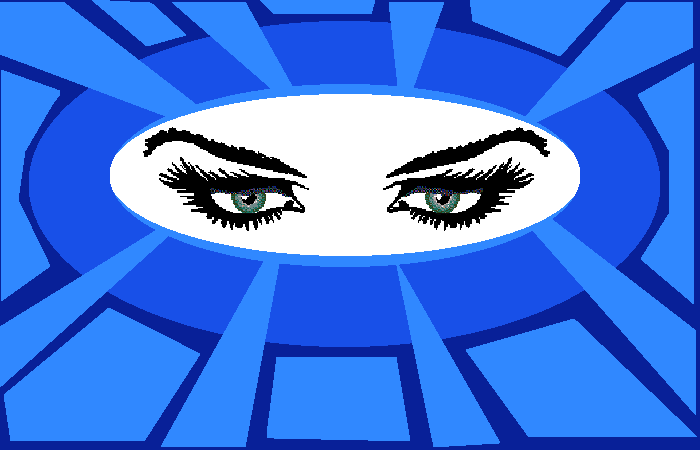
Warning: Do not place your mouse cursor here if you are subject to seizures.
Put Mouse Pointer Here to Animate
Moiré patterns are formed when two grids or line drawings are superimposed. The intersections of the lines create new patterns not present in the originals. This figure contains two drawings consisting of lines radiating from a point. One drawing is fixed and the other moves thus generating a changing interference pattern of circles that cross both points.
The animation can be stopped or re-started by pressing SHIFT and clicking on the pattern. You can also click-and-drag to control the motion of the pattern manually.
Java Applet from David Eck
The colored triangular pieces are identical, but they can be rearranged to form two "13 by 5 right triangles" that have different surface areas. This is a visual paradox that can be explained mathematically.
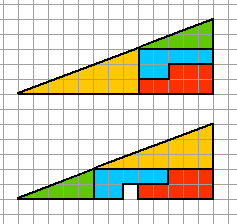
Special effects produced by computer animation enhance many modern films. Click the link below to see some short clips of Star Wars light sabers in action.

Special Effects
Humpty Dumpty is about to take a great fall because he just found out that the two red lines are equal in length. Take a ruler and connect the tops or bottoms of the red lines.

A subliminal effect is a sensory stimulus that is beneath the threshold of consciousness, but that causes us to respond instinctively in some way. Subliminal effects are exploited in horror films which use creepy music that builds up gradually to maximize the effect of an unexpected visual surprise, e.g., Jaws (1975), Psycho (1960). Marketing campaigns sometimes use subliminal visual effects that tantalize or excite us to counteract negative attitudes about a product or to increase the appeal of a product. The following figure is a portion of a picture that was widely published in advertisements during the mid 1990's. Do you know what it is?

No comments:
Post a Comment